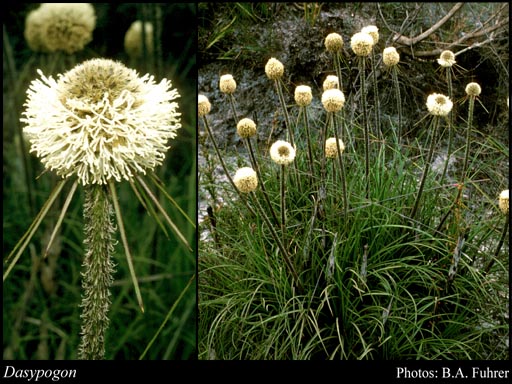- Reference
- Prodr.Fl.Nov.Holland. 263 (1810)
- Name Status
- Current







Scientific Description
Family Dasypogonaceae.
Habit and leaf form. Herbs (tufted, sometimes arborescent). Perennial. Leaves cauline, or basal and cauline. Plants with a basal concentration of leaves (more or less acaulescent), or with neither basal nor terminal concentrations of leaves; rhizomatous (short). Pachycaul. Mesophytic, or xerophytic. Leaves small to large; alternate (crowded, scattered, terminal rosette); spiral, or distichous; leathery, or modified into spines, or ‘herbaceous’; sessile; sheathing. Leaf sheaths not tubular; with free margins. Leaves simple. Leaf blades entire; flat (to inrolled); acicular, or linear; linear (or narrow linear, gradually tapered to the apex); parallel-veined; without cross-venules; imbricate, sheathing. Leaves without stipules. Leaf blade margins scabrid. Vegetative anatomy. Plants with silica bodies. Leaf anatomy. Extra-floral nectaries absent. Stem anatomy. Secondary thickening absent.
Reproductive type, pollination. Fertile flowers hermaphrodite. Unisexual flowers absent. Plants hermaphrodite.
Inflorescence and flower features. Flowers aggregated in ‘inflorescences’; in heads (of clusters of 4). Inflorescences scapiflorous, or not scapiflorous; terminal, or axillary (arborescent species); scape exceeding leaves, stout, hairy, with scattered bracts; peduncle elongate, slender, tough, with sparse bracts; inflorescences of arborescent species numerous on each stem, borne singly in leaf axils; inflorescence of other species single on each branch or stem, terminal; each cluster subtended by a bract; flowering starts from the equator of the inflorescence and proceeds to the apex and base. Flowers pedicellate, or sessile; bracteate (scape and floral; floral bracts navicular, exserted and pungent or not so, persistent); ebracteolate; small; regular; 3 merous; cyclic; pentacyclic. Perigone tube present, or absent. Hypogynous disk absent. Perianth of ‘tepals’; 6; 2 -whorled; isomerous; petaloid (the inner segments), or the outer segments hardened towards apex, dry; similar in the two whorls, or different in the two whorls; white, or cream, or yellow, or hyaline; fleshy, or non-fleshy. Androecial members definite in number. Androecium 6. Androecial members adnate; all equal; free of one another; 2 -whorled. Androecium exclusively of fertile stamens. Stamens 6 (in 2 whorls); all more or less similar in shape; diplostemonous; hypogynous or scarcely adhering to the base of the perianth. Anthers dorsifixed; versatile; dehiscing via longitudinal slits; introrse. Pollen shed as single grains. Gynoecium 3 carpelled. The pistil 1 celled, or 3 celled. Carpels isomerous with the perianth. Gynoecium syncarpous; eu-syncarpous; superior. Ovary unilocular, or plurilocular; 1 locular, or 3 locular (or incompletely 3); sessile. Gynoecium stylate. Styles 1; attenuate from the ovary, or from a depression at the top of the ovary; apical. Stigmas 1; 1 - lobed, or 3 - lobed. Placentation when unilocular, basal; when trilocular, axile. Ovules in the single cavity when unilocular, 1; 1 per locule; non-arillate; anatropous to campylotropous.
Fruit and seed features. Fruit non-fleshy; indehiscent; a capsule, or capsular-indehiscent; 1 seeded. Seeds endospermic. Embryo well differentiated. Testa without phytomelan.
Additional characters Pollen grains sulcate.
Taxonomic Literature
- Wheeler, Judy; Marchant, Neville; Lewington, Margaret; Graham, Lorraine 2002. Flora of the south west, Bunbury, Augusta, Denmark. Volume 1, introduction, keys, ferns to monocotyledons. Australian Biological Resources Study.. Canberra..
- Australia. Bureau of Flora and Fauna 1986. Flora of Australia. Volume 46, Iridaceae to Dioscoreaceae. Australian Govt. Pub. Service.. Canberra..